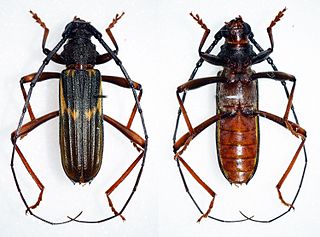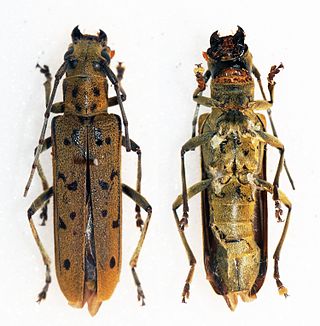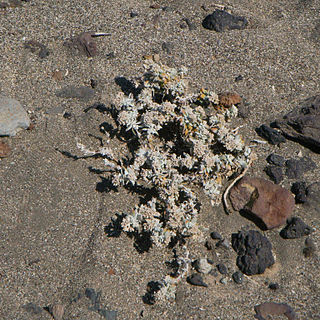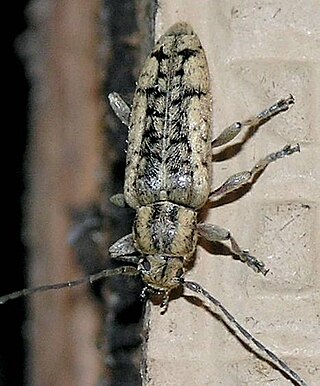
The longhorn beetles (Cerambycidae), also known as long-horned or longicorns, are a large family of beetles, with over 35,000 species described.

Heliotropium is a genus of flowering plants traditionally included in the family Boraginaceae s.l., but placed in the family Heliotropiaceae within the Boraginales order, by the Boraginales Working Group.. There are around 325 species in this almost cosmopolitan genus, which are commonly known as heliotropes. They are highly toxic to dogs and cats, as well as to humans.

Lamiinae, commonly called flat-faced longhorns, are a subfamily of the longhorn beetle family (Cerambycidae). The subfamily includes over 750 genera, rivaled in diversity within the family only by the subfamily Cerambycinae.

Leysera is a genus of African flowering plants in the tribe Gnaphalieae within the family Asteraceae.

Orthosoma is a genus of beetles in the family Cerambycidae. It is monotypic, being represented by the single species Orthosoma brunneum. The genus name Orthosoma was also previously used for a microsporidian genus. As the name is pre-occupied by this beetle genus, the name for the microsporidian has been changed to Orthosomella.

Bellamira is a genus of flower longhorns in the beetle family Cerambycidae. This genus has a single species, Bellamira scalaris, found in South America.

Bothriospilini is a tribe of beetles in the subfamily Cerambycinae, containing 11 genera which have a primarily neotropical distribution. The tribe was proposed in 1950 by Brazilian entomologist Frederico Lane as a member of the new subfamily Bothriospilinae, and with Bothriospila assigned as the type genus. The tribe is morphologically close to the tribe Torneutini, with which it has in common the same shape of the last abdominal segment, which is wide and largely braided in the female, as well as the anterior thigh cavities that are open from behind and the laterally open medial cavity.

Chrotoma is a genus of long-horned beetles in the family Cerambycidae. There is a single species in Chrotoma, C. dunniana, found in the southwest United States and northern Mexico.
Pronocera is a genus of long-horned beetles in the family Cerambycidae. There are at least three described species in Pronocera.
Crioprosopus is a genus of long-horned beetles in the family Cerambycidae. There are about 13 described species in Crioprosopus.

Teucrium gnaphalodes is a plant species in the genus Teucrium. It is endemic to the Iberian Peninsula and grows at altitudes between 200 and 1500 m. It flowers from March to July.

Callimoxys is a genus of long-horned beetles in the family Cerambycidae. There are about eight described species in Callimoxys.
Ceylania ceylonica is a species of beetle in the family Cerambycidae, and the type species of its genus. It was described by Stephan von Breuning in 1979. It is known from Sri Lanka.

Eutetrapha sedecimpunctata is a species of beetle in the family Cerambycidae. It was described by Victor Motschulsky in 1860, originally under the genus Saperda. It is known from North Korea, Russia, Japan, and China.

Polycarpaea nivea is a species of flowering plants in the family Caryophyllaceae. The species was described by William Aiton in 1828 as Achyranthes nivea, and it was placed in the genus Polycarpaea by Philip Barker Webb in 1849. The specific name nivea is Latin for "white as snow", and refers to the colour of the plant.
Megaderus is a genus of long-horned beetles in the family Cerambycidae. There are at least two described species in Megaderus.

Atimia is a genus of long-horned beetles in the family Cerambycidae. There are about 13 described species in Atimia.

Typocerus lunulatus is a species of flower longhorn beetle of the family Cerambycidae. It is found in North America.
Neospondylis is a genus of long-horned beetles in the family Cerambycidae. There are at least two described species in Neospondylis.

Tournefortia gnaphalodes, the sea lavender, bay lavender, sea rosemary, iodine bush, or beach heliotrope, is a species of flowering plant in the family Boraginaceae. It is native to Florida, Mexico, Central America, the Caribbean, Bermuda, northeastern Colombia, and Venezuela. A semi‑succulent evergreen shrub reaching 5 ft (1.5 m), it is typically found in coastal areas. Occasionally cultivated as an ornamental, it is often used for dune stabilization.















